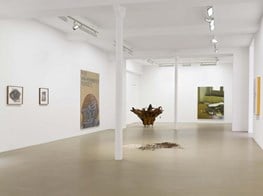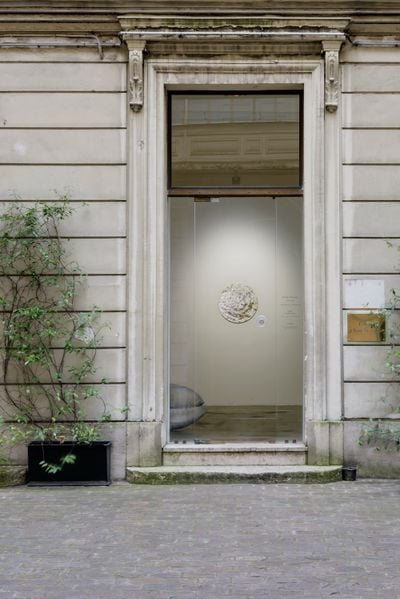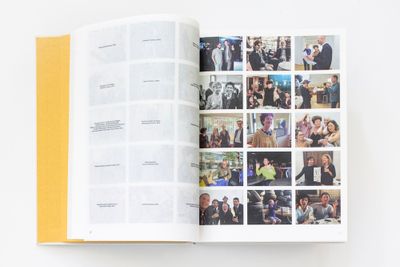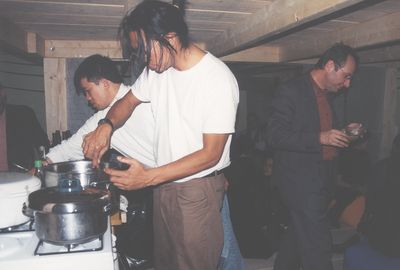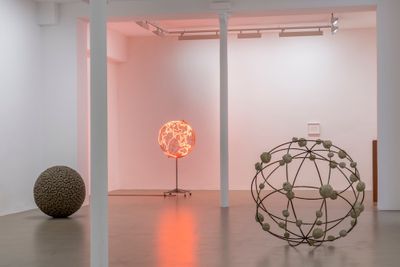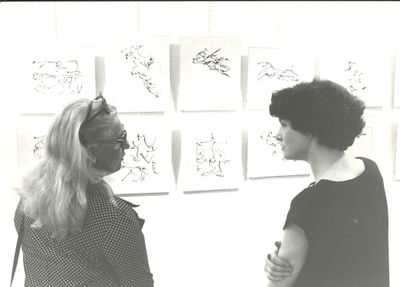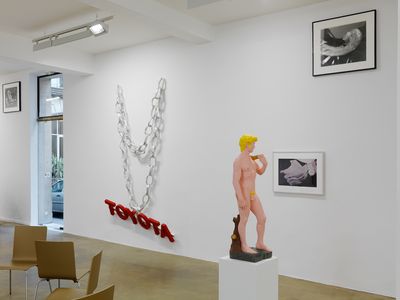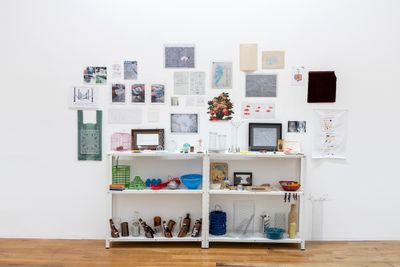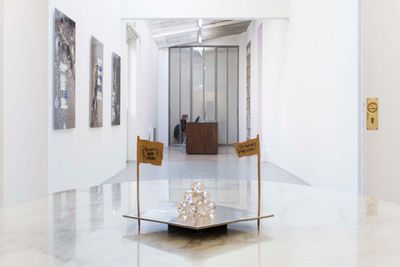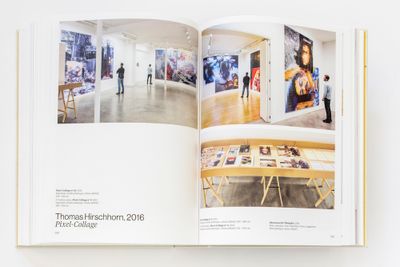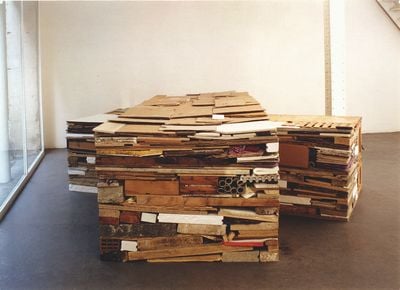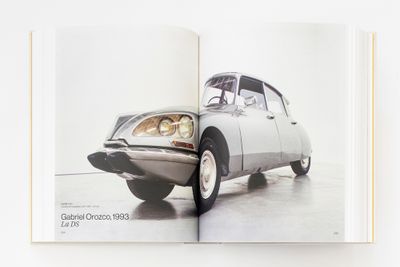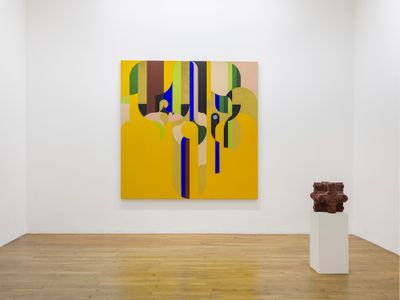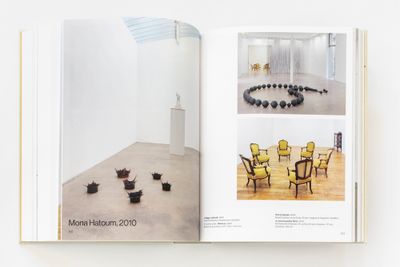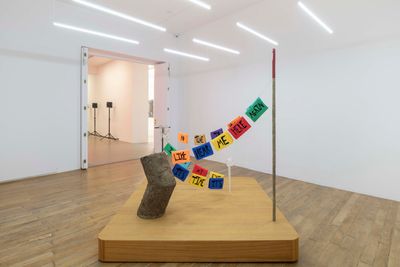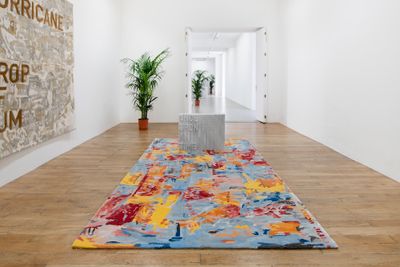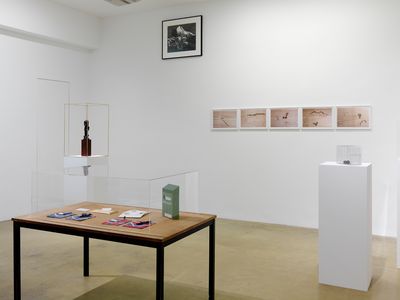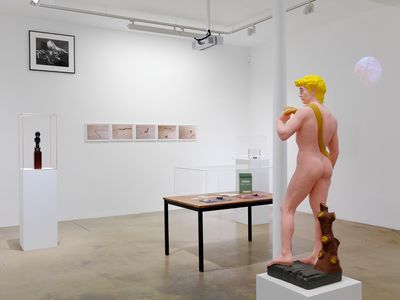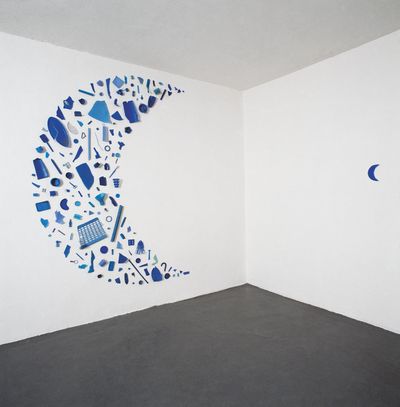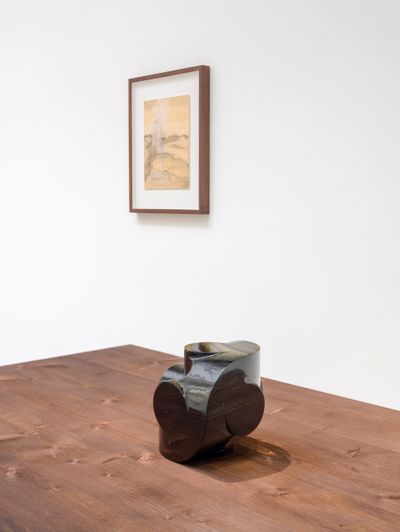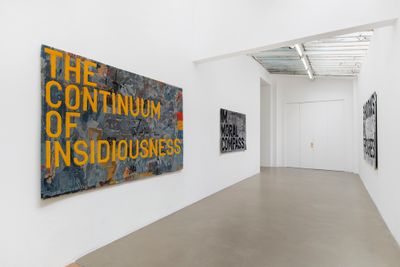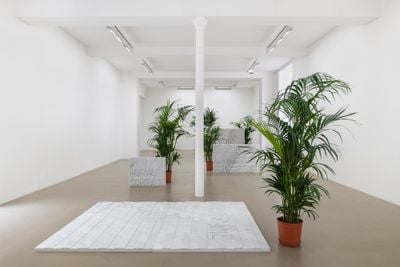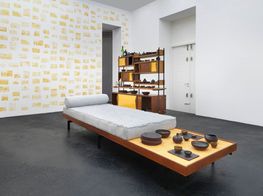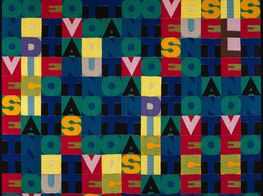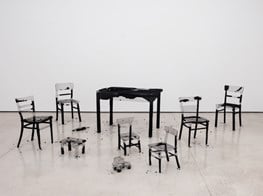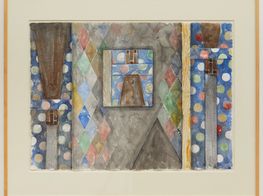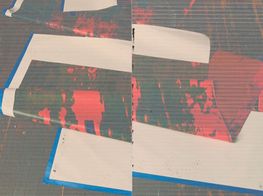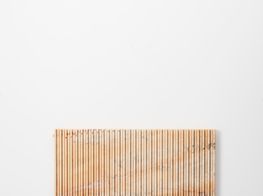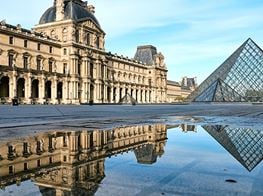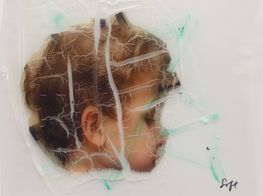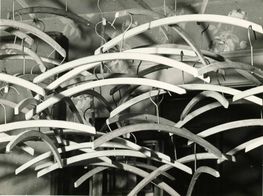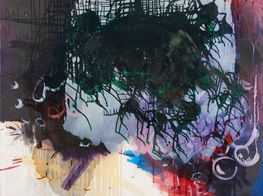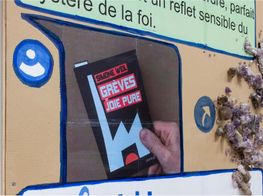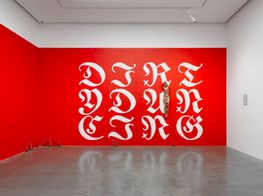Galerie Chantal Crousel at 40: Looking Back, Looking Forward
Chantal Crousel and Niklas Svennung (2015). Photo: Sebastiano Pellion di Persano.

Chantal Crousel and Niklas Svennung (2015). Photo: Sebastiano Pellion di Persano.
Chantal Crousel came to Paris from Belgium in 1972, where she pursued a correspondence course in art history with ICART, with a thesis that focused on the CoBrA movement and its founder Christian Dotremont.
Works from the photographic series 'Logoneiges' by Dotremont would form the inaugural exhibition of the first gallery that Crousel established in 1976 with fellow ICART student Jacques Blazy—a space named La Dérive that sought to bring the worlds of African, Asian, and Pre-Columbian art in dialogue with contemporary art practices.
Then, in 1980, Crousel established her namesake gallery in Paris, which is celebrating its 40th anniversary this year with a dedicated publication named after a work by Dotremont titled Jure-moi de jouer (Swear That You'll Play). For Crousel, the title defines the gallery's ethos: 'The true pleasure of playing is not to win, but to invent new rules. To cross borders, and with each step discover a centre of the world.'
Tony Cragg was the one of the first artists to exhibit with Galerie Chantal Crousel, and the gallery soon distinguished itself for its international scope, participating with Art Basel for the first time in 1982, and hosting the first exhibitions in France for artists like Alighiero Boetti, Gabriel Orozco, Mona Hatoum, and Rirkrit Tiravanija, whose first project with the gallery with artist Lincoln Tobier, Radio Printemps, took place in 1996.
In 2020, Tiravanija staged his sixth solo show with the gallery, untitled 2020 (once upon a time) (after jasper johns) (9 May–10 October 2020), which centred around the artist's slogan works, here rendered on Aubusson rugs displaying maps of the U.S. that refer to those made by Jasper Johns between 1960 and 1965.
Galerie Chantal Crousel is now directed by Crousel's son, Niklas Svennung, who joined the gallery in 2000. Svennung has worked to build on Crousel's expansive scope, drawing on his years working in New York City to develop relationships with Wade Guyton, Reena Spaulings, and Seth Price, among others; while supporting an international artist roster that includes Hassan Khan, whose recent show The Keys to the Kingdom at Madrid's Palacio de Cristal, Parque del Retiro, was organised by the Reina Sofia Museum, and Tarek Atoui, who was part of the Okayama Art Summit and Venice Biennale in 2019, with a solo exhibition, Cycles in 11, showing at the Sharjah Art Foundation until April 2021.
In this conversation, which marks the launch of the gallery's 40th anniversary publication, Crousel and Svennung reflect on their origins in art, the lessons they've learned along the way, and what makes a good gallerist.
SBChantal, you came to Paris from Belgium in 1972, when you started to study art history. What led you to Paris?
CCWhen in 1971 my companion Ivar Svennung told me that his work would move from Ghent to Paris and so would we, I immediately decided that this was the moment to shift to my long-time interest and passion: art history.
Right away, from Belgium, I started my studies by correspondence at ICART, a Paris-based school with university equivalence for art history. Since I had to define the subject for my thesis, I chose the CoBrA movement, because the members of this movement—living in Copenhagen, Brussels, and Amsterdam—were within my reach, geographically as well as mentally.
The CoBrA movement had a border-breaking dynamic, and brought together, in exhibitions and in the innovative CoBrA magazine, artists and thinkers from all five continents who were eager to exchange and amplify new artistic and political ideas.
SBOne pivotal moment for you was spotting a Man Ray drawing in a shop window while working for a forklift company in Brussels. You've said the lady explained the work so well that you bought it from her—did that trigger the gallerist in you?
CCIn 1970, the confrontation with a Man Ray etching in a Brussels gallery indeed prompted my decision to engage in the vocation of a gallerist.
Working with artists, you learn to be tested... in your beliefs, your guts, and your wallet!
The Man Ray work was an etching for Gui Rosey's Le Jugement dernier, from his series 'Electro-Magie' (1969). The small and delicate work moved me deeply. The gallerist who explained the place of this work in Man Ray's oeuvre opened my eyes and inspired me to discover unknown works, share visions, and enrich other people's worlds.
SBAnd then in 1976 you founded the gallery La Dérive.
CCAs soon as I had finished my studies, my classmate from ICART, Jacques Blazy, and I began thinking of opening a gallery together, so we founded La Dérive.
In French, 'la dérive' has many meanings, mostly related to the notion of leaving the established or targeted track. It suggests opening new paths, taking risks, and developing a different activity than being devoted to recognised, digested works.
SBCould you talk about how the vision you had for this first space has evolved through your gallery now, which you opened in 1980?
CCFor me, la dérive means to deviate from the mainstream—to engage in the unknown and discover. This direction is still valid today as one of present orientations.
In a different way, but with a similar spirit, this approach has constantly animated my gallery activities, as it focuses on accompanying artists whose works bring new and sometimes disorienting visions, thoughts, and artistic forms to the existing art scene.
SBThe first show staged at La Dérive was a solo with CoBrA founder Christian Dotremont a year before he died, and you have named the publication celebrating the gallery's 40th anniversary after Dotremont's work for that show, Jure-moi de jouer (Swear That You'll Play).
Could you talk about the significance of this work for you?
CCChristian Dotremont wrote that phrase in the frozen snow during what he knew was probably his last journey. These words do not need to be further explained to understand the gravity and playfulness of his provocation. Throughout these 40 years, and in the future, this playful gravity and engagement has defined my life attitude. It has brought me where I want to be.
I chose this sentence as the title of the publication that looks back into the gallery's history, and to announce future projects and encounters to be shared in the coming years, in what will be a world of re-centred values.
SBNiklas, looking back, what memories do you have of the gallery growing up that particularly stand out?
NSI remember a white and often quiet alternative space for homework and play. Indeed, I would spend quite some hours often impressed by the wide white space, amused by the freedom of expression that would contrast with the strict French education guidelines. In the gallery there were much fewer guidelines and more material and linguistic experiences. Freedom, to summarise.
SBThis must have been an incredible education—did you always know you wanted to get into art?
NSAs a 12-year-old I remember a playful and beautiful Tony Cragg dice sculpture, which I thought was the best ever use of random mathematics, and a French revolution Sigmar Polke painting, the best use of a celebrated chapter of French history.
Our international scope has, since the beginning, been based on content, essential meaning, and original and universal form.
As a teenager, I recollect a negroni cocktail bar performance by Rirkrit Tiravanija. I was offered a rather complete education; how could I turn all of that down?!
I started helping out with the mailings, which helped me to gather a series of names of people I wanted to meet and countries I wanted to travel to. I helped as an art handler between the ages of 15 and 20, assisting with installing shows and at art fairs like Art Basel, Art Brussels in the early nineties, and even Guadalajara art fair in 1995.
Then, in 1997, I got the chance to take an internship at David Zwirner in New York City, which gave me an insight into the New York scene and the American way of artists and the market. The Passerby bar founded by Gavin Brown and his artists was famous back then. Those were other layers of my education.
I stayed four years in NYC, learning, reading, assisting Rirkrit, hanging out with Gabriel Orozco, as well as with the younger emerging art scene. I remember doing the first exhibition of Thomas Hirschhorn in the U.S. in 1998 at the Gramercy Art Fair, in the hotel; I even managed to sell the work!
SBThat must have been a thrilling sell! On that note, what are some of the most important skills that you've developed when it comes to the business of art, and how do you do that without losing sight of the art itself?
NSBeing raised in Paris by two foreign parents influenced and inspired by so many talented and generous artists, with different cultures and backgrounds, I feel I've had a chance to develop a strong adaptation capacity, to mentalities, cultures, and collecting patterns.
I try to avoid the monolithic standpoint on people and their backgrounds. I think that reflects in the diversity of clients we now have that range from far away provinces in China to deep counties in the U.S., via fantastic old master and contemporary collections in France and Italy.
Having had access to outstanding collections at an early age made me understand what the potential of collecting actually meant, and that was before the market became what it is today. Back then, historical value was a purpose and a real drive for many collectors.
Nowadays, I keep trying to have people think long term. It's very helpful to make the best choices, saving a lot time and money.
SBYou joined the gallery in 2000. How did you grow into the role of partner?
NSIt all came rather gradually. From the beginning, my mother was always keen in having her kids involved. But it was also triggered when I invested shares in the gallery from my father's inheritance. It then became a concrete continuum and I started to think with a longer perspective.
The roots were strong, but it took time for me to build my own vision and test its complementarity to my mother's strong signature. As I joined the gallery in 2000, Chantal had just met Anri Sala. He quickly became an important learning and playing partner of the same age.
I learned to be patient and had to grow more mature. Progressively, we agreed on new artists and collaborations. The most evident conscious and common decisions came as we discovered Wade Guyton in New York in 2008.
I then developed and extended the gallery's relationship with Reena Spaulings, and then shortly after with Seth Price. My earlier New York years naturally came back in the picture. Another highlight was the intense and playful relationship we both established with Danh Vo, whom we both fell for in 2010, followed by David Douard, and more to come!
SBIs it correct that Danh Vo had you buy an American flag at auction for participation in the group show Bijoux de famille in 2009?
NSWorking with artists, you learn to be tested... in your beliefs, your guts, and your wallet! I remember being asked by Danh for our first collaboration to bid for an American flag in an obscure military auction in Virginia.
He wanted us to acquire and show the flag, and when I asked him how high he thought we should bid, he said it was up to us to decide how much we wanted that piece in the show. We had to be playful!
SBThinking about memorable encounters, Chantal you were an intern for Alexander Iolas before establishing your own gallery, a storied collector and gallerist remembered as the man who discovered Warhol. What impact did Iolas have on you?
CCDuring my studies, and as part of the study process, I worked for six months as an intern at Alexander Iolas, who was a very passionate, risk-taking, and inspiring gallerist. A free mind.
Through this period, I became intimately familiar with some of the main actors of Surrealism: Victor Brauner, Max Ernst, as well as essential contemporary artists: Jean Tinguely, Niki de Saint-Phalle, Öyvind Fahlström, and Takis, among others.
SBAside from Iolas, who have been some of the most influential figures for you when it comes to your work in the arts? You met Tony Cragg when visiting Jan Hoet, director of the Museum of Contemporary Art in Ghent in 1979, and Cragg would become the first artist you showed when you opened your current gallery in 1980.
CCIn his ground-breaking exhibition Art in Europe after '68, Jan Hoet, one of the most inspired museum directors of the 1980s and 90s, gathered a number of mainly European or Europe-based artists whose visions and creative innovations changed the perception of art, and of the art scene. Tony Cragg was one of them. When I had this chance to discover his work with Jan Hoet, a the Museum in Ghent, it was a true shock.
Paris is strong place for artistic debate as it tries and struggles to emancipate from its own history.
And indeed, Tony Cragg was one of the first artists to show in my gallery, but also to install a large work from the Ghent exhibition in the garage of Pierre & Marie Curie Hospital, as part of the gallery exhibition. This was possible thanks to the complicity of the head of this hospital and a passionate collector: Robert Calle.
SBChantal, in your career, some collectors have played an especially important role. When the gallery came close to bankruptcy in the early 1990s during the financial crisis, for instance, you have talked about the invaluable support of collector Maja Hoffmann, as well as artist Sigmar Polke. At that time, what was it like to pick up the pieces and start again?
CCThe financial crisis in the early nineties brought the gallery in serious danger. My partners wanted to pull out. I wanted to continue. The gallery space had just been enlarged, and the bank loan had to be reimbursed monthly.
Thanks to the accomplices you mention, as well to the support of my two children, who invested in some artworks with their father's inheritance, but not least with the support and faith of some artists whose first exhibitions at the gallery were a major confirmation and incentive to continue this beautiful and necessary mission, the gallery kept strong. Since then, we have not stopped to evolve and prosper.
SBDo you feel echoes of those times now with the Covid-19 pandemic? How have you navigated these times?
NSI am personally embracing this pause. I could have not continued with the exponential global travelling pattern that was imposed by an ever-growing, yet successful, business. I think we have a chance to reset and define what is the essential artistic need both for the market and our environment.
It is hard to imagine decreasing our ambition, but the demand will decide on the offer. I also hope the pause will also be an improvement for the quality of the exchanges. I am glad the size of our current model enables that flexibility and that we don't have to make any cuts.
SBHow do you think Covid might change the art world?
NSI think it will scrap a thick layer of superficial consumption and discourse. But for how long?
SBWhile the gallery is solely based in Paris, it established an international programme from the outset—how has this international scope evolved in the last decades?
CCOur international scope has, since the beginning, been based on content, essential meaning, and original and universal form. This has not changed through time.
Both Niklas and I feel it is essential to travel, be in a position where you emerge in an unfamiliar yet essential culture, which leads to analyse and distillate what is worth adding to the dialogues and exchanges we want to develop in our own geographical 'centre' of Paris. Biennials, or the essential art fairs, as well as accompanying our artists on their exhibitions worldwide, naturally replaces the need for a gallery satellite besides our platform in Paris.
NSAs long as artists give us the best they have for Paris, I won't feel the urge to offer them an alternative in another country. So far, I feel the focus we have here has been a way for both the gallery and our artists to be true to ourselves and not just operators of a brand abroad.
It is a privilege to have the gallery in Paris, which is one of the most diverse artistic cities in the world. It is both living on a strong heritage, which makes it internationally competitive, and is a fantastic stimulation for our artists to address the world from here.
I think of our current Tiravanija show, and there is undoubtedly a favourable landscape here to address both art history as much as global issues. Rirkrit uses several layers of the Duchampian readymade tool, and by evoking Jasper John's choice of the American flags, he adds perspective to american politics.
I don't think Rirkrit would have addressed these questions in the U.S.; Paris is a strong place for artistic debate as it tries and struggles to emancipate from its own history.
SBFinally, I wanted to quote something that Niklas has said about artists: 'Artists have the capacity to express changes in society, which is difficult to perceive. In their field of action, they can also have a political dimension. When one perceives the limits of a form of expression—photography or painting for example—trying to go beyond them is a political attitude.'
In turn, how would you define the practice of a good gallerist?
NSIt seems a gallery can help to ask relevant questions, pinpoint undetected subject matters, or an unpredicted climate. A good gallery has to simply transmit the sensitivity of artists that react to these interesting times. The most interesting artists are often early, and therefore need to find support for the risks they take.—[O]

